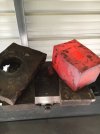- Joined
- Oct 16, 2010
- Messages
- 5,715
Greetings gents:
I've been hankering to build my own San Mai hunters and bowies and Chef knives. I know it can be done by hammering it by hand, but I don't believe there's enough life left in me to go that route. I've been looking at the the 24 ton press by Riverside Machinery. I'm inclined to go for a press rather than a hammer because of the noise/neighbors. I like the 2' x 3' footprint and the 2 second cycle time is OK with me.
https://www.riversidemachine.net/ecommerce/uncleal-s-hydraulic-press.html
Does this press have enough oomf to get the job done? Reliability experiences any of you care to share?
I've been hankering to build my own San Mai hunters and bowies and Chef knives. I know it can be done by hammering it by hand, but I don't believe there's enough life left in me to go that route. I've been looking at the the 24 ton press by Riverside Machinery. I'm inclined to go for a press rather than a hammer because of the noise/neighbors. I like the 2' x 3' footprint and the 2 second cycle time is OK with me.
https://www.riversidemachine.net/ecommerce/uncleal-s-hydraulic-press.html
Does this press have enough oomf to get the job done? Reliability experiences any of you care to share?

